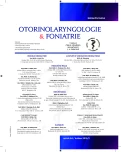Our Experience with the Technique of Flexible Intubation between 2001 and 2014
Authors:
P. Staněk
Authors‘ workplace:
Klinika otorinolaryngologie a chirurgie hlavy a krku LF MU a FN u sv. Anny, Brno, přednosta prof. MUDr. R. Kostřica, CSc.
Published in:
Otorinolaryngol Foniatr, 64, 2015, No. 2, pp. 102-106.
Category:
Review Article
Overview
Between the years 2001 and 2014, the Department of Otorhinolaryngology and Head and Neck Surgery, St. Anne’s Faculty Hospital in Brno, performed, within the frame of its consultation activity, altogether 403 flexible intubations in 374 patients (220 men and 154 women). Of this number, 234 cases were acute states and in 169 situations the flexible form of intubation had been planned in advance. Altogether 13 physicians took part in the interventions in various measure and extent, and in 42 situations the classical intubation method by the anaesthesiologist was unsuccessful. The most frequent indications for flexible intubation were surgeries on the thyroid gland and large surgical interventions associated with the lower airways. These were followed by internal and neurological indications, operations from the fields of neurosurgery and orthopaedics, and interventions from the fields of dental surgery, urology, and ophthalmology. Also, otorhinolaryngological problems had specific traits and indications of their own, especially the surgical part of head and neck oncology and, last but not least, traumatic conditions in the area of the head and the cervical spine. To a lesser extent, cardiosurgical indications as well as plastic and aesthetic surgeries were also represented.
The technique of flexible intubation is an effective alternative to the classical intubation method and, moreover, with only minimal contraindications. However, it requires not only adequate technical equipment but also a specially trained team, preferably from the ranks of otorhinolaryngologists.
Keywords:
flexible intubation, endoscopy of the airways, intubation cannula
Sources
1. Barrett, Jr, C. R.: Flexibile fiberoptic bronchoskopy in the critically ill patient. Methodology and indications. Chest, 73, 1978, 5, s. 746-749.
2. Benumof, J. L.: Management of the difficult airway: The ASA algorithm, ASA Refresher Courses in Anestesiology, 22, 1994, s. 39-63.
3. Bouaggad, A., Nejmi, S. E., Bouderka, M. A., Abbassi, O.: Prediction of difficult tracheal intubation in thyroid surgery. Anesth. Analg., 2004, 99, s. 603-606.
4. Dvořáková, H., Šetka, J., Balaš, V., Linhart, O., Šváb, J., Douba, M.: Přínos urgentní endoskopie při rozhodování chirurga. Čs. Gastr. Výž., 31, 1977, 7, s. 470-480.
5. Goskowicz, R., Colt, H. G., Voulelis, L .D.: Fiberoptic tracheal intubation using a nipple guide. Anaesthesiology, 85, 1996, s. 1210-1211.
6. Heidegger, T., Ferit, H. J.: Algorithms for management of the difficulty airway. Cur Opin. Anaesthesiol., 17, 2004, s.483-484.
7. Heidegger, T., Ferit, H. J., Keller, C.: Comparison of algorithms for management of difficult airway. Anaesthetist, 2003, 52: s. 381-392.
8. Heir, J. S., Kupferman, M. E.: A simple approach to facilitating fiberoptic intubation in the difficult airway. The Laryngoscope, 121, 2011, 2, s. 310-312.
9. Hutchinson, J. C., Cardalelli, D. D., Faber, L. P., Friedberg, S. A.: Alternative uses for the flexibile fiberoptic bronchoscope in otolaryngology. The Laryngoscope, 37, 1977, 2, s. 180-186.
10. Iseli, T. A., Iseli,C. E., Golden, J. B., Jones,V. L., Boudreaux, A. M., Boyce, J. M., Weeks, D. M., Carroll, W. R.: Outcomes of intubation in difficult airways due to head and neck patology. The Laryngoscope, 119, 2009, 3, s. 242.
11. Kretz, F. J.,Teufel, F.: Anaesthesie und Intensivmedizin. 5. vydání, Heidelberg, Springer, 2006, s. 695.
12. Kristensen, M. S.: The parker flex-tip tube versus a standard tube for fiberoptic orotracheal intubation : a randomized double-blind study. Anaesthesiology , 98, 2003, 2, s. 354-358.
13. Lejska, V., Medřická, D.: Prodloužená endotracheální intubace z hlediska otolaryngologa. Čs. Otolarygolog., 26, 1977, 1, s. 27-30.
14. Mallampati, S. R, Gatti, S. P., Gugino, L D.: A clinical sign to predict difficult intubation: a prospective study. Can. Anaesth. Soc. Journal, 32, 1985, s. 429-434.
15. Mason, R. A.: Learning fibroptic intubation: Fundamental probléme. Anaesthesia, 47, 1992, 9, s. 729-731.
16. Miller, F. P., Vandome, A. F., McBrewster, J.: Intubation. VDM Publishing House, Ltd., 2010, ISBN-978-6130677268.
17. Ovassapian, A., Krejcie,T. C.: Awake fiberoptic intubation in the patient at high risk of Aspiration. British Journal Anaesth., 6, 1989, s. 13-16.
18. Ovassapian, A., Dykes, M.: The role of fiberoptic endoscopy in airway management, Sem. Anesth., 6, 1987, s. 93-104.
19. Ovassapian, A.: Fibeoptic endoscopy and the difficult airway. 2nd ed. Philadelphia, Lippincott-Raven Press, 1996.
20. Pandit, J. J., Dravid, R. M., Iyer, R., Popat, M. T.: Orotracheal fibreoptic intubation for rapid sequence induction of anaesthesia. Anaesthesia, 57, 2002, 2, s. 123-127.
21. Sldhu,V. S., Whitehead, E. M., Ainsworth, Q. P., Smith, M., Calder, I.: A technique of awake fibreoptic intubation. Anaesthesia, 48, 1993, 10, s. 910-913.
22. Smith, J. E., Jaskson, A. P. F.: Learning fibreoptic endoskopy. Anaesthesia, 55, 2000, 11, s. 1072-1075.
23. Stacey, M. R., Rasam, S., Sivasankar, R., Hall, J. E., Latto, I. P.: A comparison of direct laryngoscopy and jaw thrust to aid fibreoptic intubation, Anaesthesia, 60, 2005, 5, s.445-448.
24. Stringer, K. R, Bajenov, S., Yentis, S. M.: Training in airway management. Anaesthesia, 57, 2002, s. 967-983.
25. Škeřík, P., Nosek, Š.: K aktuálním otázkám perorální endoskopie v otorinolaryngologii. Prakt. lékař, 60, 1980, s. 455-477.
26. Wheeler, M., Ovassapian, A.: Fiberoptic endoscopy - aided techniques. In: Carin Hagberg, Benumof´ s Airway Management: Principles and Practice, s. 399-438.
27. Yentis, S. M.: Predicting trouble in airway management, Anaesthesiology, 105, 2006, s. 871-872.
Labels
Audiology Paediatric ENT ENT (Otorhinolaryngology)Article was published in
Otorhinolaryngology and Phoniatrics

2015 Issue 2
Most read in this issue
- Augmentation of Vocal Cords by Autologous Fat
- Present Diagnostics and Therapy of Inflammations of Maxillary Sinuses in the Czech Republic – Evaluation of a Questionnaire Survey
- Juvenile Recurrent Parotitis and Selective IgA Deficiency
- Massive Cervical Hematoma Developed Due to Spontaneous Rupture of External Carotid Artery
